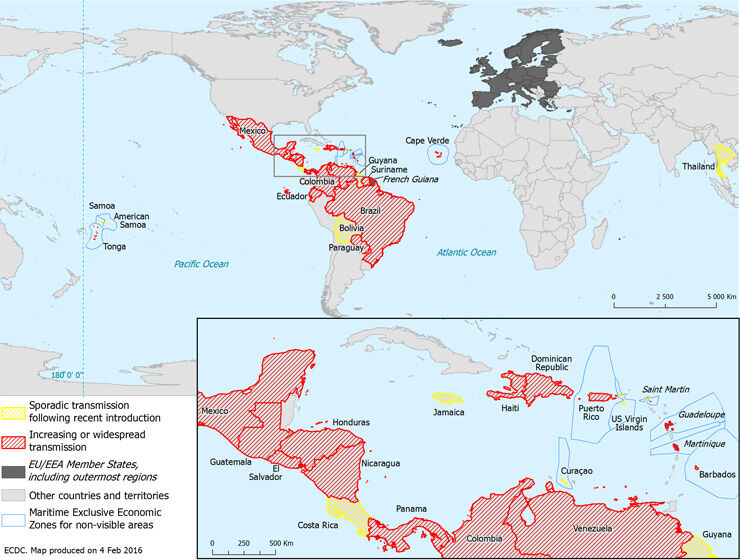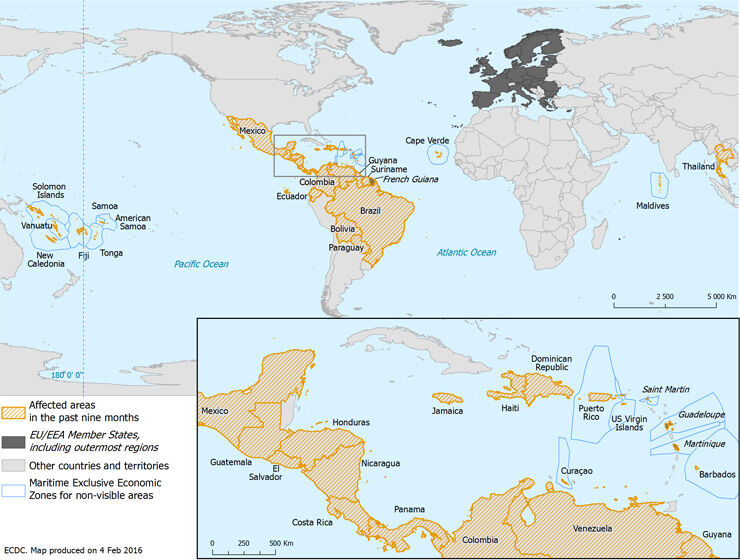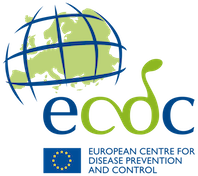Epidemiological update: Outbreaks of Zika virus and complications potentially linked to the Zika virus infection
On 1 February 2016, following the first meeting of the Emergency Committee convened by the Director-General under the IHR 2005 regarding clusters of microcephaly cases and other neurologic disorders in some areas affected by Zika virus, WHO declared a Public Health Emergency of International Concern (PHEIC).
On 1 February 2016, following the first meeting of the Emergency Committee convened by the Director-General under the IHR 2005 regarding clusters of microcephaly cases and other neurologic disorders in some areas affected by Zika virus, WHO declared a Public Health Emergency of International Concern (PHEIC).
The Committee advised that surveillance for microcephaly and Guillan–Barré syndrome (GBS) should be standardised and enhanced, particularly in areas of known Zika virus transmission and areas at risk of such transmission. Research into the aetiology of new clusters of microcephaly and neurologic disorders should be intensified to determine whether there is a causative link to Zika virus and/or other factors or co-factors.
As a precautionary measure, the Committee provided a list of additional recommendations regarding Zika virus transmission, travel, data sharing and longer-term measures to consider. The full statement about the PHEIC and temporary recommendations can be accessed on WHO’s website.
The Zika virus epidemic continues to spread in the Americas. Since last week, five additional countries or territories have reported laboratory-confirmed autochthonous transmission in the past two months: American Samoa, Samoa, Costa Rica, Jamaica and Tonga.
In addition, in the USA on 2 February, Dallas County Health and Human Services received confirmation from the US CDC of a Zika virus case acquired through sexual transmission in Dallas County in 2016. The patient was infected after having had sexual contact with an ill person who returned from a country affected by the Zika epidemic.
On 3 February 2016, according to local health authorities in Brazil, transmission of Zika virus through blood transfusion occurred in Sao Paulo state in early 2015.
As of 4 February 2016, autochthonous cases of Zika virus infection have been reported from 31 countries or territories worldwide in the past two months (see Table 1 and Figure 1).
In addition, as of 4 February 2016, 36 countries or territories have reported autochthonous cases of Zika virus infection in the past nine months (see Table 1 and Figure 2):
Table 1. Countries and territories with reported confirmed autochthonous cases of Zika virus infection in the past two months, as of 4 February 2016
| Countries and territories | Affected in the past two months | Affected in the past nine months |
|---|---|---|
| American Samoa | Sporadic transmission following recent introduction | Yes |
| Barbados | Increasing or widespread transmission | Yes |
| Bolivia | Sporadic transmission following recent introduction | Yes |
| Brazil | Increasing or widespread transmission | Yes |
| Cape Verde | Increasing or widespread transmission | Yes |
| Colombia | Increasing or widespread transmission | Yes |
| Costa Rica | Sporadic transmission following recent introduction | Yes |
| Curaçao | Sporadic transmission following recent introduction | Yes |
| Dominican Republic | Increasing or widespread transmission | Yes |
| Ecuador | Increasing or widespread transmission | Yes |
| El Salvador | Increasing or widespread transmission | Yes |
| Fiji | No | Yes |
| French Guiana | Increasing or widespread transmission | Yes |
| Guadeloupe | Increasing or widespread transmission | Yes |
| Guatemala | Increasing or widespread transmission | Yes |
| Guyana | Sporadic transmission following recent introduction | Yes |
| Haiti | Increasing or widespread transmission | Yes |
| Honduras | Increasing or widespread transmission | Yes |
| Jamaica | Sporadic transmission following recent introduction | Yes |
| Maldives | No | Yes |
| Martinique | Increasing or widespread transmission | Yes |
| Mexico | Increasing or widespread transmission | Yes |
| New Caledonia (France) | No | Yes |
| Nicaragua | Increasing or widespread transmission | Yes |
| Panama | Increasing or widespread transmission | Yes |
| Paraguay | Increasing or widespread transmission | Yes |
| Puerto Rico | Increasing or widespread transmission | Yes |
| Saint Martin | Sporadic transmission following recent introduction | Yes |
| Samoa | Sporadic transmission following recent introduction | Yes |
| Solomon Islands | No | Yes |
| Suriname | Increasing or widespread transmission | Yes |
| Thailand | Sporadic transmission following recent introduction | Yes |
| Venezuela | Increasing or widespread transmission | Yes |
| Tonga | Increasing or widespread transmission | Yes |
| Vanuatu | No | Yes |
| Virgin islands (US) | Sporadic transmission following recent introduction | Yes |
EU/EEA and EU Outermost Regions
As of 4 February, no autochthonous Zika virus transmission has been reported in the EU. However, in 2015 and 2016, media reports quoting Ministries of Health reported several EU countries with imported cases who had recently travelled in affected countries/territories. These countries are Austria, Denmark, Finland, France Germany, Ireland, Italy, Portugal, the Netherlands, Spain, Sweden and the UK. In Europe outside the EU, Switzerland also reported imported cases.
Several outermost EU regions continue to report autochthonous transmission: Martinique, Guadeloupe, Saint Martin, French Guiana and Curaçao.
- Martinique: From December 2015 to 29 January 2016, 2 287 suspected cases were reported by the local health authorities. This is an increase of 1 064 cases since the last report.
- French Guiana: From December 2015 to 29 January 2016, authorities reported 245 suspected cases and 59 confirmed cases. This is an increase of 115 suspected and 13 confirmed cases since the last report.
- Guadeloupe: On 29 January, ten confirmed autochthonous case were reported. This is an increase of nine cases since the last report.
- Saint Martin: On 15 January, a confirmed autochthonous case was reported.
- Curaçao: One confirmed autochthonous case reported on 28 January 2016.
Figure 1.Countries and territories with reported confirmed autochthonous cases of Zika virus infection in the past two months, as of 4 February 2016

Note: the map does not indicate the extent of the autochthonous transmission in the countries.
Figure 2.Countries and territories with reported confirmed autochthonous cases of Zika virus infection in the past nine months, as of 4 February 2016

Note: the map does not indicate the extent of the autochthonous transmission in the countries.
Update on the observed increase of congenital microcephaly and other central nervous system symptoms
- Brazil: According to the Ministry of Health weekly epidemiological update on the monitoring of microcephaly published on 2 February (data as of 30 January), 4 783 suspected cases of microcephaly have been reported since week 43-2015, of which 1 132 (24%) were investigated and classified. Of these cases, 404 (36%) have confirmed microcephaly and/or central nervous system malformations, 17/404 (4%) were positive for Zika virus infection. Of 76 suspected deaths from microcephaly and congenital central nervous system malformations, 15 were investigated and confirmed to have microcephaly and/or central nervous system malformations. Zika virus was detected in tissues from five of them.
- El Salvador: On 30 January, media quoting the Ministry of Health reported 104 cases of GBS between 1 December 2016 and 30 January 2016.
- Martinique: On 29 January, authorities reported two cases of GBS in confirmed Zika virus cases.
- France: On 3 February, French authorities reported one imported case of Zika infection with neurological symptoms out of nine imported cases of Zika virus in 2016.
- New Zealand: On 29 January, the Ministry of Health reported one patient with GBS who has also had a laboratory-confirmed (imported) Zika virus infection in the past. The case had recent travel history in the South Pacific region.
- Venezuela: On 13 January, authorities reported 23 GBS cases. However, on 29 January, media quoting the Ministry of Health reported 255 GBS cases. Among these cases, 55 required admission in intensive care units.
Additional information may be found in the latest ECDC risk Assessment (link).
See the latest information on countries and areas with local Zika transmission




